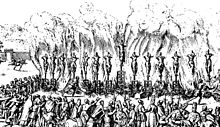Antonio Herrezuelo
Around 1551, the Italian Carlos de Seso, son of the Bishop of Piacenza (Catalan Trivulzio), founded a Protestant conventicle in Valladolid, the former seat of the Spanish court.
He had converted to Lutheranism the previous year, probably under the influence of the works of Juan de Valdés, and brought reformist texts into Spain.
Among his early converts to the Protestant faith were Herrezuelo and his wife Leonor de Cisneros - they had married in 1553 - and other notables.
[2] On January 4, 1559 Pope Paul IV granted a Spanish request by the Grand Inquisitor, Valdés, and the Council of the Supreme General Inquisition, to confirm a heresy conviction where an abjuration was offered, if the probable intent was to evade punishment.
The Auto-da-fé ("Act of Faith") was the ceremonial religio-legal process adopted by the Inquisition, in a Church-State alliance, whose initial target was mainly prominent Jews, Moriscos and the wealthy elites.
When the tribune envoys visited Augustino Cazalla on the eve of his execution they found him in a dark cell, loaded with chains, wearing a pié de amigo although he had freely confessed, recanted, and begged for mercy.
On the eve of the execution the condemned prisoner learned their fate, and received a last inducement to recant by the offer of the “grace” of garrotting (strangulation) prior to being burned at the stake.
The unrepentant heretic wore the penitential cloak called a "sanbenito" - a loose sleeveless yellow woollen cloth, knee-length and open at the neck, similar to a scapular- on his head was a high peaked cap called a “tiare” and walked with hands bound in front and bearing a flaming torch of green wax.
Before the palace on a special stage in the royal box, was the regent Infanta Juana, the sister of King Philip II, her nephew, the crown prince of Asturias, the 13-year-old Infante Don Carlos, the Archbishop of Santiago de Compostela, Gaspar Zúñiga Avellaneda (term 1558-1569), the whole court and many nobles, attended the pre-dawn ceremony.
In the foreground a cross wrapped in black cloth was carried, with the red flag of the Inquisition, bearing the names of the Pope and the King; these items were finally stowed on their own scaffolding.
Next to it was a pulpit from which Melchior Cano, a well-known, learned Dominican and Bishop of the Canaries, gave the one-hour sermon for the autodafé.
[6] After the ceremony, the Inquisitor of Valladolid, Francisco Baca, went to the tribune of the Infante and Infanta, and asked both to take an oath to protect the Inquisition and denounce any opponent of the Roman Catholic faith.
Under this regulatory procedure of the Spanish Inquisition, which the royal couple Ferdinand and Isabella had introduced, the performing magistrate of the autodafé, would demand a corresponding oath.
Carlos and Juana responded to the request and took the oath on the cross in the Missal of the Archbishop of Seville, and received a blessing.
Baca's approach was held an affront to the Crown and Don Carlos' attitude to the Inquisition remained negative for life.
However, Antonio Herrezuelo alone refused to recant and was the only one of the eighteen convicts to be burned alive a Protestant martyr on this occasion.
At the execution site in front of the Puerta del Campo, the condemned to death were accompanied by many armed men, riding donkeys, facing backwards.
Illescas later reported that Herrezuelo remained as still as a flintstone without a lament or regret uttered, though he is said to have had a strangely sad expression at the moment of death.
Simon Vestdijk processed the fate of Antonio Herrezuelo and Leonor de Cisnere in his novel about El Greco, see [3].

